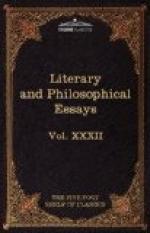the vivid impression of her magic, accompanied by
the sorrowful feeling that man knows, when, face to
face with her, he believes that he hears her commune
with him concerning his origin and his destiny.
The legend of Merlin mirrors this feeling. Seduced
by a fairy of the woods, he flies with her and becomes
a savage. Arthur’s messengers come upon
him as he is singing by the side of a fountain; he
is led back again to court; but the charm carries
him away. He returns to his forests, and this
time for ever. Under a thicket of hawthorn Vivien
has built him a magical prison. There he prophesies
the future of the Celtic races; he speaks of a maiden
of the woods, now visible and now unseen, who holds
him captive by her spells. Several Arthurian
legends are impressed with the same character.
Arthur himself in popular belief became, as it were,
a woodland spirit. “The foresters on their
nightly round by the light of the moon,” says
Gervais of Tilbury, [Footnote: An English chronicler
of the twelfth century.] “often hear a great
sound as of horns, and meet bands of huntsmen; when
they are asked whence they come, these huntsmen make
reply that they are of King Arthur’s following.”
[Footnote: This manner of explaining all the unknown
noises of the wood by Arthur’s Hunting is still
to be found in several districts. To understand
properly the cult of nature, and, if I may say so,
of landscape among the Celts, see Gildas and Nennius,
pp. 131, 136, 137,
etc. (Edit. San Marte,
Berlin. 1884);] Even the French imitators of the Breton
romances keep an impression—although a
rather insipid one—of the attraction exercised
by nature on the Celtic imagination. Elaine,
the heroine of Lancelot, the ideal of Breton perfection,
passes her life with her companions in a garden, in
the midst of flowers which she tends. Every flower
culled by her hands is at the instant restored to
life; and the worshippers of her memory are under
an obligation, when they cut a flower, to sow another
in its place.
The worship of forest, and fountain, and stone is
to be explained by this primitive naturalism, which
all the Councils of the Church held in Brittany united
to proscribe. The stone, in truth, seems the
natural symbol of the Celtic races. It is an immutable
witness that has no death. The animal, the plant,
above all the human figure, only express the divine
life under a determinate form; the stone on the contrary,
adapted to receive all forms, has been the fetish of
peoples in their childhood. Pausanias saw, still
standing erect, the thirty square stones of Pharse,
each bearing the name of a divinity. The men-hir
to be met with over the whole surface of the ancient
world, what is it but the monument of primitive humanity,
a living witness of its faith in Heaven? [Footnote:
It is, however, doubtful whether the monuments known
in France at Celtic (men-hir. dot-men, etc.)
are the work of the Celts. With M. Worsaae and
the Copenhagen archaeologists, I am inclined to think
that these monuments belong to a more ancient humanity.
Never, in fact, has any branch of the Indo-European
race built in this fashion. (See two articles by M.
Merimee in L’Athenaum franfais, Sept. 11th, 1852,
and April 25th, 1853.)]




